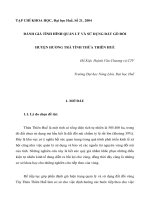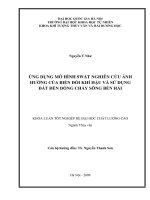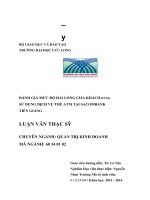EFFECTS OF FACEBOOK TO THE YOUTH
Bạn đang xem bản rút gọn của tài liệu. Xem và tải ngay bản đầy đủ của tài liệu tại đây (217.9 KB, 12 trang )
EFFECTS OF FACEBOOK TO THE YOUTH
INTRODUCTION
I.
II.
Time: 19-25/3/2015
Total research samples: 60
Research area: Son Tra district .
Purpose: to examine the impact level of Facebook on youth people.
ANALYSIS:
1. Description:
a. Gender:
In our survey, we asked 60 people in total. the percentages of genders are
showed in the following chart.
Frequency
Percent
Valid Percent
29
29
2
60
48.3
48.3
3.3
100.0
48.3
48.3
3.3
100.0
Female
Male
Other
Total
The
and males are
females and 29
of females and
2 people in the other sex,
b.
Cumulative
Percent
48.3
96.7
100.0
percentages of females
equal to each other: 29
males corresponding to 48.3%
48.3% of males. Besides, there are
which makes up 3.3%.
Age
Statistics in Business |
1
The surveyed ages are between 13 and 30. 19, 20, 21 and 22 year-old people are
examined most.
Statistics in Business |
2
Statistics
Age
N
Valid
Missing
Mean
Median
Mode
Variance
Skewness
Std. Error of Skewness
Kurtosis
Std. Error of Kurtosis
Range
Minimum
Maximum
Percentiles
25
50
75
60
0
20.27
20.00
20
11.555
.564
.309
1.492
.608
17
13
30
19.00
20.00
22.00
The average age is 20.27.
The median is 20, 20 is also the age that is surveyed most.
The youngest person is 13 years old while the oldest is 30. Their range is 17 years
old.
Percentiles are 19, 20, 22
These numbers are relevant to our target people: the youth.
c. Entities: pupils, students and graduates.
Statistics in Business |
3
Pupil
Student
Graduate
Total
Frequency
11
41
8
60
Entities
Percent
Valid Percent
18.3
18.3
68.3
68.3
13.3
13.3
100.0
100.0
Cumulative Percent
18.3
86.7
100.0
There are 11 pupils, constituting 18.3%
There are 8 graduates, constituting 13.3%
University students are the most with 68.3%
Statistics in Business |
4
=> The entity group that is examined most is University student.
d. Having Facebook accounts:
Have a Facebook account
Frequency
Percent
Valid Percent Cumulative Percent
Yes
59
98.3
98.3
98.3
Used to
1
1.7
1.7
100.0
Total
60
100.0
100.0
59 over 60 people surveyed have a Facebook account.
Statistics in Business |
5
A large number of young people use Facebook.
e.
Average used time per day
Young people spend from 2 to 5 hours a day on average using Facebook.
Abuse
Facebook, spend less time
on
other
things,
real life,….
Statistics in Business |
6
Correlation
a. Correlation between gender and confidence level :
There is a marked difference between males and females.
Description
2.
Gender
Confidence
level on
Facebook's
information
Female
Std.
Stat.
Error
Mean
6.10
0.378
Male
Std.
Stat.
Error
3.93
0.324
Other
Std.
Stat.
Error
3
Lower
Bound
5.44
3.12
-22.41
Upper
Bound
6.76
4.74
28.41
5% Trimmed
Mean
6.25
3.77
.
Median
6.00
4
3
Variance
Std.
Deviation
3.025
4.495
8
1.730
2.12
2.828
Minimum
1
1
1
Maximum
8
10
5
Range
7
9
4
95%
Confidence
Interval for
Mean
2
Skewness
-1.045
0.434 1.184
0.434
.
.
Kurtosis
1.153
0.845
0.845
.
.
1.801
The average confidence level of women is 6.1 while men is lower - 3.93. the
other gender is the lowest: just 3
In short, women seem to trust facebook information more than men.
Statistics in Business |
7
b. Correlation between the average friend number and the average
“like” number
Symmetric Measuresc
Asymp. Approx. Approx.
Value Std. Errora
Tb
Sig.
Ordinal by
Kendall's tau.471
.088
4.927
.000
Ordinal
b
Kendall's tau.415
.084
4.927
.000
c
Gamma
.680
.109
4.927
.000
N of Valid Cases
60
Average number of friends * Average number of Likes Crosstabulation
Average number of Likes
<20
20-100 100-500 > 500
Total
Average number <200
1
2
0
0
3
of friends
200-500
1
8
9
0
18
500-1000
0
2
7
3
12
>1000
0
4
12
11
27
Total
2
16
28
14
60
The average like number and the average friend number are 2 hierarchical criteria.
Thus, Gamma and Kendall’s tau coefficients are used to illustrate the correlation
of them.
Gamma = 0.68
Kendall’s tau = 0.571
Two coefficients are positive and close to 1.
It means 2 criteria have positive association and closely related to each other.
Which is “the more friends a person has, the more like numbers he/she gets”.
That is also expressed through the above table.
The average like number depends on the average friend number… On Facebook,
the number of likes demonstrates one person’s popularity. Therefore, many young
Statistics in Business |
8
people using Facebook have a tendency to make friends with more people in order
to receive more like numbers and thus show off their fame.
c. Age & Impact level of Facebook on yourself (correlate – Spearman)
Correlations
Age
Spearman's rho Age
Impact level of
Facebook on
yourself
Correlation
Coefficient
Sig. (2-tailed)
N
Correlation
Coefficient
Sig. (2-tailed)
N
Impact level of
Facebook on
yourself
1.000
.005
.
60
.970
60
.005
1.000
.970
60
.
60
The correlation coefficient: r = 0.05 ( it closes to 0 ) => correlated quite
unclosely. This shows that age and the impact of Facebook correlation, the age
is not significantly relative to the impact of Facebook.
HYPOTHESIS TESTS
a.
One sample T-test
Test the hypothesis: the average confidence level is equal to or greater than 6.
H0 : u >= u0
u0 = 6
H 1 : u < u0
This is the LHS test.
3.
One-Sample Statistics
Std.
N
Mean Deviation
Confidence level on
Facebook's
information
60
4.17
1.993
Std. Error
Mean
.257
Statistics in Business |
9
One-Sample Test
Test Value = 6
t
Confidence level
on Facebook's
information
-7.126
Sig. (2tailed)
Df
59
Mean
Difference
.000
-1.833
95% Confidence
Interval of the
Difference
Lower
Upper
-2.35
-1.32
t=-7.126 <0 and sig 1-tailed =0.0000 < a => reject H(0) , accept H(1)
Hence, the average confidence level is less than 6
From the above result, we can see that the confidence level on Facebook’s
infomation is low (it equals to 4.17)
b.
Paired Samples T-Tests
Test the hypothesis: the average confidence level is greater than or equal to the
average impact level
H(0 ) : u(x)-u(y) >=0
X : the average confidence level, Y : the average impact level
H(1) : u(x)-u(y) <0
This is the LHS test.
Paired Samples Statistics
Mean
Pair 1 Confidence level on
Facebook's
information
Impact level of
Facebook on
yourself
Std.
Deviation
N
Std. Error
Mean
4.17
60
1.993
.257
6.67
60
1.664
.215
Statistics in Business |
10
Paired Samples Correlations
Correlatio
N
n
Pair 1 Confidence level on
Facebook's
information &
60
.053
Impact level of
Facebook on
yourself
Sig.
.689
Paired Samples Test
Paired Differences
95% Confidence
Interval of the
Std.
Std.
Difference
Deviati Error
Mean
on
Mean Lower Upper
Pair 1 Confidence
level on
Facebook's
information
-2.500 2.528
- Impact
level of
Facebook on
yourself
.326
-3.153 -1.847
t
7.661
df
59
Sig.
(2tailed)
.000
t <0 , sig 1-tailed=0.0000 < a
=> reject H(0) , accept H(1)
So the average confidence level is less than the average impact level
Although young people are impacted by Facebook at high level, confidence
level on Facebook’s information is low
Statistics in Business |
11
III.
CONCLUSION
A large number of young people use Facebook.
Females seem to trust Facebook information more than males.
Many young people using Facebook tend to make friends with more people to
receive more like numbers and thus show off their fame.
The difference in ages is not relative to the impact of Facebook to people.
Although Facebook have the great impact level on young people, they seem not
be believe in it.
FACEBOOK HAS A GREAT INFLUENCE ON YOUNG PEOPLE!
Statistics in Business |
12









